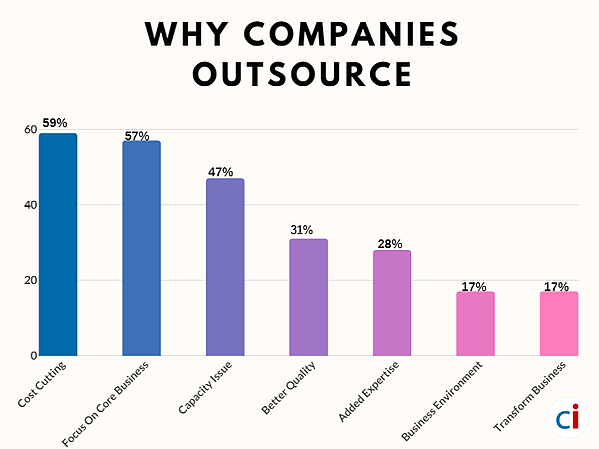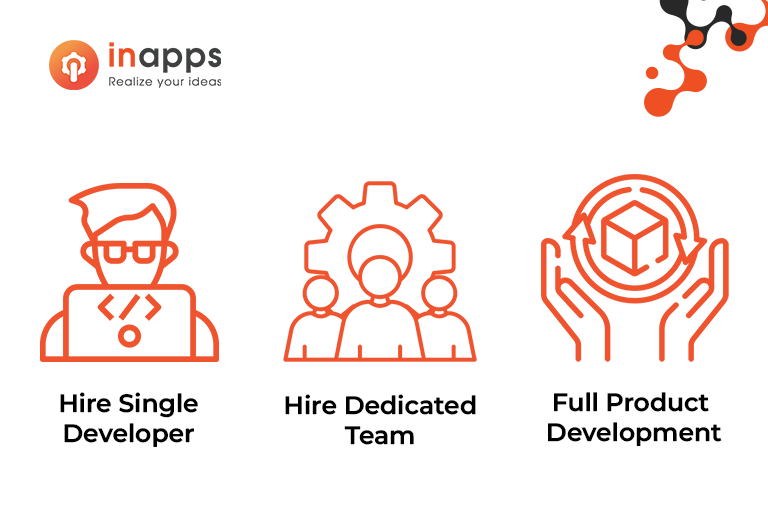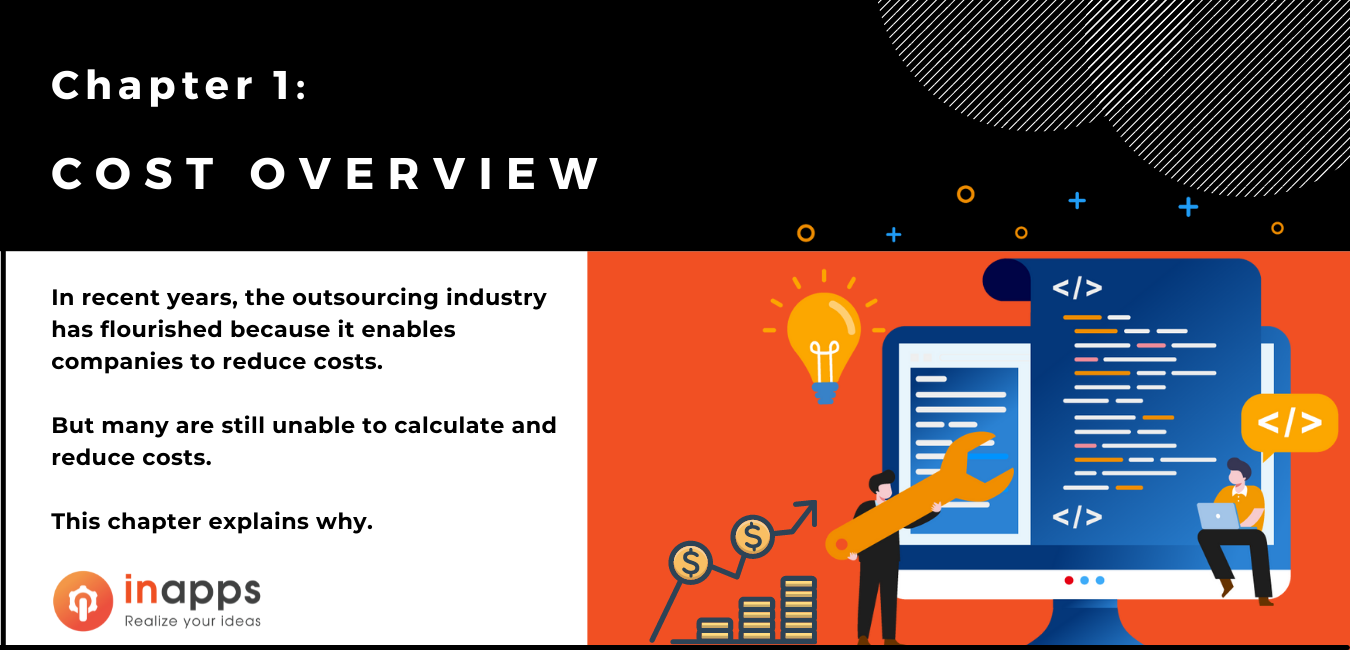- Home
- >
- Offshore News
- >
- How Much Software Outsourcing Costs (+ Examples)
For business owners, starting, launching, and growing a business is about doing it within a budget. Software outsourcing is a smart way to get the expertise you need without spending too much money. But, many business owners are still not sure about hiring help from other countries for software projects.
This guide is here to help clear up any confusion about outsourcing costs. We’ll help you understand how to calculate these costs and share some great tips and tricks to spend reasonably. Let’s get started!
1. Why do companies outsource their software development?
Outsourcing is not a new technology, but it has been used in industry since the 1960s; it has grown into a mammoth in the past half-century. A Deloitte Global Outsourcing Survey highlighted that 65% of outsourcing work has helped companies align more focus on important business functions, with 63% experiencing cost-cutting in the overall budget.
With increasing cyber threats, 83% of IT leaders are considering outsourcing their security efforts, recognizing the cost benefits and the need for specialized expertise. Statista IT Outsourcing reports that revenue from the IT Outsourcing market is expected to hit $512.50 billion in 2024. The market’s income is predicted to grow by about 11% each year from 2024 to 2028, reaching a total of $777.70 billion by 2028.
So why software outsourcing is growing strong? Here are key reasons why:
Cost Efficiency
Outsourcing can significantly reduce costs related to hiring, training, and maintaining an in-house software development team. Companies save on salaries, benefits, workspace, and equipment by paying only for the services they need when they need them.
Access to Global Talent
Outsourcing provides access to a global pool of skilled professionals and specialists in various technologies and domains. This enables companies to find the exact expertise they need for their projects, which might be scarce or more expensive locally.
Focus on Core Business
By outsourcing software development, companies can focus more on their core business activities and competencies. This allows them to allocate more resources and attention to strategy, marketing, customer service, and other areas that directly contribute to their competitive advantage and revenue growth.
Scalability and Flexibility
Outsourcing allows companies to quickly scale their development efforts up or down based on project needs without the long-term commitments associated with hiring employees. This flexibility supports dynamic business environments and changing market demands.
Faster Time to Market
With dedicated external teams working on their software projects, companies can accelerate development cycles and bring products to market faster. This is critical in industries where speed to market can significantly impact market share and revenue.
Risk Mitigation
Outsourcing partners often have robust project management and quality assurance processes in place, reducing the risk of project failures. Additionally, outsourcing can help distribute and manage risks associated with software development, including technical challenges and project management issues.
Technological Advantages
Outsourcing companies often invest in the latest technologies, tools, and best practices to stay competitive. By partnering with such firms, companies can benefit from these advancements without directly investing in new technologies or training.
Operational Efficiency
Outsourcing firms specialize in software development and usually have efficient processes, tools, and methodologies. This operational efficiency can lead to higher quality outputs and productivity gains for the client companies.

Why companies outsource by percentage Source: Classic Informatics
2. Can you calculate the actual outsourcing costs?
Some companies are essentially organized and data collectors. They know the importance of analyzing the operating costs of their business and can compare the two estimates. But for those who need to put in more effort, calculating the actual costs of outsourcing can be a challenge.
Before you start outsourcing and study outsourcing costs in more detail, you should pay attention to your ongoing costs. One of the biggest obstacles companies face when outsourcing is their low-cost awareness. This term refers to the difficulty in grasping the full expenses associated with owning and operating aspects of a business. The challenge doesn’t end at merely understanding costs, as there are multiple hurdles in accurately calculating them.
Organizations often encounter significant obstacles, including:
- Collecting data can be messy and incomplete, which makes it hard to get all the information you need.
- Once you have the data, making sense of it can be complicated, making it tough to understand what the numbers tell you.
- Getting people or different parts of the business to work together is crucial for getting a full picture of costs, but it’s not always easy to achieve.
There are also problems with correct cost estimation which will hinder your success when outsourcing. Lack of complete information about operating costs may prevent you from understanding the true outsourcing costs. Before considering outsourcing to cut costs, you need to calculate the actual cost of operating your business.
3. Calculate Software Outsourcing Costs
To break down the cost of outsourcing, let us look at the actual outsourcing costs, the bills associated with the company, and the hidden costs.
3.1 What are the direct software outsourcing costs?
If you outsource IT, Web development, or other services, it’s important to understand outsourcing costs better without knowing how much we need to pay in advance. These are the main components of outsourcing costs.
Salary or check
Cost is mainly the remuneration or salary you pay to remote developers or the team you hire to develop remote products. Depending on the needs of your project, you may need to hire a developer to work on your project with your own company or your entire team or even hope that another company will manage all product development.

outsourcing cost
Hire a single/free developer
You can hire a developer, full-time programmer, or programmer to work on your project for hours, or months or sign a long-term contract as needed.
When is the best time for you to hire developers?
- You need someone to meet your specific technical needs
- Expert needs for the project
You can save all the money you get by paying only the time remote developers work for you. Otherwise, you will have to spend some time and rest when the internal developers are not working. This is the cost that you might have to pay for hiring a remote product developer from Vietnam. The cost is only $20 per hour, and the maximum is $45 per hour. For other countries/regions, the cost may range from US$50 to US$150.
Hiring a completely remote team
If you are looking for a team to develop or design a specific part of a product, you can hire a remote team. Such teams include developers, designers, evaluators, QA and QA managers, and designers. Or equipment used for specific tasks (such as design, development, etc.). You can form a team to carry out comprehensive work abroad or form a team to extend your internal team. A dedicated team is part of your internal team, but working in different locations. They can set your salary and use the skills they bring to the project.
When should a complete development team be hired?
- It would be best if you had a dedicated team to handle complex projects
- You want to include a team of experts as an extension of the internal team
Getting a complete product team, and everyone develops from the outside Personnel to the internal team housing developers, quality maintenance analysts, and support, complete equipment, etc., can reduce costs. You don’t have to hire experts from any field alone, and you will get a team that understands all the professionals you need.
View more: Hire offshore development team
Complete product development
In this process, you will join a company that will fully manage your project or product development, from brainstorming to creating an MVP and launching it after being tested by a hosted project.
When should product development start?
- It would be best if you built a complex product or software architecture.
- From product ideas to development, implementation, and expansion, you need a partner.
You only need to provide your ideas and your specific details to the company that wants to integrate the software. For managed product development projects, you need to submit requirements, obtain a quotation from an outsourcing agency, form a team, and complete the design. You can even assign a project manager, so you can even save on product development management costs.[/su_box]
Read more: A complete guide to benefit from MVP Development
3.2 What are the hidden software outsourcing costs?
When considering outsourcing software development, it’s easy to focus mainly on the direct costs, such as paying the outsourcing company for the project or the salaries of remote developers. However, this perspective overlooks several hidden costs that can significantly affect the overall expense and efficiency of outsourcing.
Let’s break down some of these hidden costs.
- Employment Costs: Even though you’re hiring another company to do the work, sometimes you might still end up paying for things related to their employees. This could include training their staff to do your work the way you want it done.
- Transfer or Knowledge Costs: When you start working with the outsourcing company, you’ll need to teach them about how your business works and what you expect from them. This transfer of knowledge takes time and effort, which costs money.
- Server Management Costs: If your outsourcing involves IT or online services, you might need to use special servers to share information or run programs. Managing these servers can add extra costs.
- Outsourcing Contract Drafting Costs: Just getting the contract ready to go can be pricey. You might need lawyers or consultants to help draft the contract, review it, and make sure it protects your interests.
3.3 How to calculate outsourcing costs in total (+ examples)
Add the direct costs and the estimated hidden costs to arrive at the total outsourcing costs. This comprehensive total will give you a clearer understanding of what outsourcing will truly cost your business.
Let’s say you’re considering outsourcing a software development project and want to calculate the total outsourcing cost, taking into account both direct and hidden costs. Here’s a simple demo example to guide you through the process.
Step 1: Direct Costs
- Salary for Remote Developers: $40/hour
- Project Duration: 6 months (approx. 960 hours, assuming a full-time developer works 160 hours/month)
- Total Direct Salary Costs: $40/hour * 960 hours = $38,400
Step 2: Hidden Costs
- Employment Costs (additional benefits, taxes, etc. for the outsourced team, estimated at 20% of direct salary costs): $38,400 * 20% = $7,680
- Knowledge Transfer Costs (training and orientation for the outsourced team, estimated at $2,000)
- Server Management Costs (monthly server hosting for the project, $100/month * 6 months): $600
- Contract Drafting Costs (legal fees for drafting and reviewing the outsourcing contract, estimated at $1,000)
Step 3: Calculate Total Outsourcing Cost
- Total Direct Costs: $38,400
- Total Hidden Costs: $7,680 (Employment Costs) + $2,000 (Knowledge Transfer Costs) + $600 (Server Management Costs) + $1,000 (Contract Drafting Costs) = $11,280
- Total Outsourcing Cost: $38,400 (Direct Costs) + $11,280 (Hidden Costs) = $49,680
This example shows that the total cost of outsourcing the project is $49,680, including the direct costs of paying the remote developers and the hidden costs associated with employment, knowledge transfer, server management, and legal fees. Remember, this is a simplified example, and the actual costs can vary based on the project’s complexity, the outsourcing partner’s location, and other factors.
I hope this article on how to calculate outsourcing costs provides you with value. If you’re interested, click below for more articles like this. If you want to hire the InApps Technology software team, check out our portfolios, and let’s get in touch!
Let’s create the next big thing together!
Coming together is a beginning. Keeping together is progress. Working together is success.




















